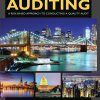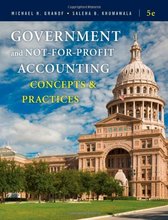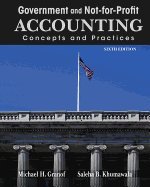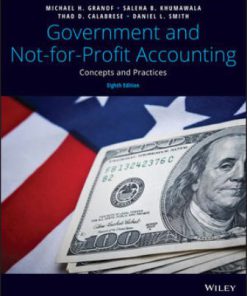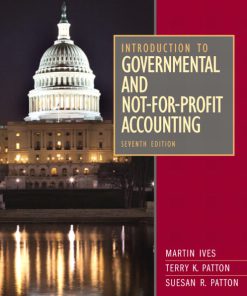Test Bank for Government and Not-For-Profit Accounting: Concepts and Practices, 7th Edition
$35.00 Original price was: $35.00.$26.50Current price is: $26.50.
Test Bank for Government and Not-For-Profit Accounting: Concepts and Practices, 7th Edition
Instant download Government and Not-For-Profit Accounting: Concepts and Practices, 7th Edition pdf docx epub after payment.
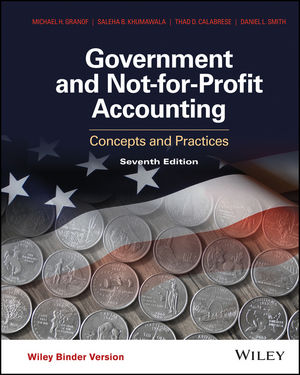
Product details:
- ISBN-10 : 1118983270
- ISBN-13 : 978-1118983270
- Author: Michael H. Granof
Government and Not-for-Profit Accounting, 7th Edition by Michael Granof, Saleha Khumawala, Thad Calabrese, and Daniel Smith makes students aware of the dynamism of government and not-for-profit accounting and of the intellectual challenges that it presents. Not only does the 7th edition keep students informed of current accounting and reporting standards and practices, but it also ensures that they are aware of the reasons behind them, their strengths and limitations, and possible alternatives.
1 The Government and Not- for- Profit Environment 1
How Do Governments and Not- For- Profits Compare With Businesses? 2
In Practice: Why Is State And Local Government Accounting Important? 6
What Other Characteristics of Governments and Not- For- Profits Have Accounting Implications? 9
How Do Governments Compare With Not-For- Profits? 12
What Are The Overall Purposes of Financial Reporting? 14
Who are The Users, and What are The Uses of Financial Reports? 14
What are The Specific Objectives of Financial Reporting As Set Forth By The GASB and The FASB? 17
Example: Clash Among Reporting Objectives 19
Do Differences In Accounting Principles Really Matter? 22
In Practice: Will Accounting Changes Make A Difference? 24
Who Establishes Generally Accepted Accounting Principles? 24
In Practice: Assessing the Profitability of An Athletic Program 25
In Practice: Governments and Not- For- Profits May Also Be Aggressive In Their Accounting 26
Summary 29
Key Terms In This Chapter 30
Questions For Review and Discussion 30
Exercises 31
Continuing Problem 33
Problems 33
Questions For Research, Analysis, And Discussion 37
2 Fund Accounting 38
What is a Fund? 39
What are the Key Elements of Government Financial Statements? 39
What Characterizes Funds? 41
Use of Multiple Funds to Account for An Entity 44
Basis of Accounting and Measurement Focus 45
Example: Fund Accounting in a School District 46
Major VS. Nonmajor Funds 49
How Can Funds be Combined and Consolidated? 49
What are the Main Types of a Government’s Funds? 59
What’s Notable About Each Type of Governmental Fund? 61
What’s Notable About Each Type of Proprietary Fund? 64
What’s Notable About Each Type of Fiduciary Fund? 70
What is Included in a Government’s Annual Comprehensive Financial Report (ACFR)? 71
Example: Government-Wide Statement of Activities 74
How Do the Funds and Annual Reports of Not-For-Profits Differ From Those of Governments? 75
Summary 78
Key Terms In This Chapter 80
Exercise for Review and Self-Study 80
Questions for Review and Discussion 81
Exercises 82
Continuing Problem 85
Problems 86
Questions for Research, Analysis, and Discussion 91
Solution to Exercise for Review and Self-Study 92
3 Issues of Budgeting and Control 95
What are the Key Purposes of Budgets? 96
Why is More Than One Type of Budget Necessary? 96
How are Expenditures and Revenues Classified? 98
Why are Performance Budgets Necessary? 99
What are the Key Phases of the Budget Cycle? 101
In Practice: Budgeting In The Midst of a Pandemic 103
On What Basis of Accounting are Budgets Prepared? 105
In Practice: States Balance Their Budgets the Painless Way 106
In Practice: The Cost of GAAP 107
In Practice: Balancing the Budget by Selling Assets to Yourself 108
What Cautions Must be Taken in Budget-to-Actual Comparisons? 108
How Does Budgeting in Not-For-Profit Organizations Compare with that in Governments? 111
How Do Budgets Enhance Control? 112
What are the Distinctive Ways Governments Record Their Budgets? 114
Example: Budgetary Entries 115
An Alternative Method: Crediting or Debiting the Difference Between Revenues and Expenditures to “Budgetary Control” 117
How Does Encumbrance Accounting Prevent Overspending? 117
Example: The Encumbrance Cycle—Year 1 118
Example: The Encumbrance Cycle—Year 2 120
Example: Impact of Encumbrances on Fund Balance 121
Are Budgetary and Encumbrance Entries Really Needed? 124
Summary 125
Key Terms in this Chapter 125
Exercise for Review and Self-Study 126
Questions for Review and Discussion 126
Exercises 127
Continuing Problem 131
Problems 131
Questions for Research, Analysis, and Discussion 139
Solution to Exercise for Review and Self-Study 139
4 Recognizing Revenues in Governmental Funds 141
Why and How Do Governments Use the Modified Accrual Basis? 141
What are the Main Types of Nonexchange Revenues and the Limitations on How and When They Can be Used? 145
How Should Property Taxes and Other Imposed Nonexchange Revenues be Accounted for? 146
I n Practice: In Practice: Just as it did with individuals, corona viruses make some governments
far more sick than others 146
Example: Property Taxes 148
Example: Fines 153
How Should Sales Taxes and Other Derived Tax Revenues be Accounted for? 154
Example: Sales Taxes 154
Example: Sales Taxes Collected by State 156
Example: Income Taxes 157
What are Tax Abatements and Why and How Must They be Disclosed? 159
How Should Grants and Similar Government-Mandated and Voluntary Nonexchange Revenues be Accounted For? 160
Example: Unrestricted Grant with Time Requirement 161
Example: Grant with Purpose Restriction 162
Example: Reimbursement (Eligibility Requirement) Grant 162
Example: Unrestricted Grant with Contingency Eligibility Requirement 163
Example: Endowment Gift 163
Example: Pledges 163
Example: Donations of Land for Differing Purposes 164
Example: On-Behalf Payments 167
How Should Sales of Capital Assets be Accounted For? 167
Example: Sales of Capital Assets 168
How Should Licenses, Permits, and Other Exchange Transactions be Accounted for? 169
Example: License Fees 169
How Should Governments Report Revenues in their Government-Wide Statements? 170
Summary 171
Key Terms In This Chapter 173
Exercise for Review and Self-Study 173
Questions for Review and Discussion 174
Exercises 174
Continuing Problem 178
Problems 178
Questions for Research, Analysis, and Discussion 184
Solution to Exercise for Review and Self-Study 185
5 Recognizing Expenditures in Governmental Funds 187
Hierarchical Approach to Transaction Analysis 187
How is the Accrual Concept Modified for Expenditures? 189
How Should Wages and Salaries be Accounted for? 190
Example: Wages and Salaries 190
How Should Compensated Absences Be Accounted For? 191
In Practice: Changing the Pay Date by One Day 191
Example: Vacation Leave 192
Example: Sick Leave 193
Example: Sabbatical Leave 196
How Should Pensions and Other Postemployment Benefits Be Accounted For? 197
Example: Pension Expenditure 197
How Should Claims and Judgments Be Accounted For? 198
Example: Claims and Judgments 198
How Should the Acquisition and Use of Materials and Supplies Be Accounted For? 200
Example: Supplies 200
How Should Prepayments Be Accounted For? 203
Example: Prepayments 203
How Should Capital Assets Be Accounted For? 205
Example: Capital Assets 205
Example: Installment Notes 206
Example: Capital Leases 207
How Should Interest and Principal on Long-Term Debt Be Accounted For? 208
Example: Long-term Debt 209
In Practice: California School Children May Pay for Their Own Education 210
How Should Nonexchange Expenditures be Accounted for? 212
Example: Unrestricted Grant with Time Requirement 212
Example: Grant with Purpose Restriction 213
Example: Reimbursement (Eligibility Requirement) Grant 213
How Should Interfund Transactions Be Accounted For? 214
Example: Interfund Transfer 215
Example: Interfund Purchase/Sale 215
How Should Revenues, Expenditures, and Other Financing Sources and Uses Be Reported? 218
In Practice: Is the Coronavirus Pandemic an Extraordinary or Special Event? 218
What is the Significance of the Current Financial Governmental Fund Statements? An Overview 219
Summary 220
Key Terms In This Chapter 221
Exercise for Review and Self-Study 221
Questions for Review and Discussion 222
Exercises 223
Continuing Problem 227
Problems 227
Questions for Research, Analysis, and Discussion 233
Solution to Exercise for Review and Self-Study 233
6 Accounting for Capital Projects and Debt Service 236
How do Governments Account for Capital Projects Funds? 237
Example: Bond Issue Costs 239
Example: Bond Premiums and Discounts 239
Comprehensive Example: Main Types of Transactions Accounted for in Capital Projects Funds 241
How do Governments Account for Resources Dedicated to Debt Service? 245
Comprehensive Example: Main Types of Transactions Accounted for in Debt Service Funds 246
How do Governments Handle Special Assessments? 250
In Practice: Use and Abuse of Special Assessments 252
In Practice: What We Might Learn from “Net Investment in Capital Assets” 256
Why is Arbitrage a Concern of Governments? 256
How can Governments Benefit from Debt Refundings? 258
Example: Debt Refundings 258
Example: In-Substance Defeasance 260
In Practice: Current and Advance Refundings 261
Summary 263
Key Terms in This Chapter 264
Exercise for Review and Self-Study 264
Questions for Review and Discussion 265
Exercises 265
Continuing Problem 270
Problems 270
Questions for Research, Analysis, and Discussion 277
Solution to Exercise for Review and Self-Study 278
7 Capital Assets and Investments in Marketable Securities 281
What Accounting Practices Do Governments Follow for General Capital Assets? 282
Acquiring and Placing Value on Capital Assets 285
Example: Trade-Ins 285
Why and How Should Governments Report Infrastructure? 287
In Practice: Nation’s Infrastructure Earns a Cumulative Grade of C-287
In Practice: Fair Values May (Or May not) Facilitate Sales Decisions 292
How Should Governments Account for Assets that Are Impaired? 294
Example: Restoration Approach 294
Example: Service Units Approach 295
Example: Deflated Depreciated Replacement Cost Approach 296
What Are the Critical Issues with Respect To Marketable Securities And Other Investments? 297
Investments Should Be Reported at Fair Values 297
Example: Investment Income 300
I n Practice: Some Governments May Make Suboptimal Investment Decisions in Order to Avoid Financial Statement Volatility 301
Example: Interest Income 303
In Practice: One Common-Type Derivative 305
In Practice: Investment Debacles 305
In Practice: Common Sense Investment Practices 307
Summary 307
Key Terms In This Chapter 308
Exercise for Review and Self-Study 308
Questions for Review and Discussion 309
Exercises 309
Continuing Problem 312
Problems 313
Questions for Research, Analysis, and Discussion 320
Solution to Exercise for Review and Self-Study 320
8 Long-Term Obligations 321
Why is Information on Long-Term Debt Important to Statement Users? 322
Can Governments and Not-For-Profits Go Bankrupt? 322
In Practice: It is not So Easy to Declare Municipal Bankruptcy 323
How Do Governments Account for Long-Term Obligations? 325
Example: Accounting for Bonds in Government-Wide Statements 327
In Practice: Valuing a Lottery Prize 328
What Constitutes a Government’s Long-Term Debt? 329
Example: Demand Bonds 331
Example: Bond Anticipation Notes 332
Example: Tax Anticipation Notes 333
Example: Lessee Accounting 335
Example: Lessor Accounting 336
Example: Overlapping Debt 343
In Practice: 49Ers Score Big in the Financial Arena 346
I n Practice: Tobacco Bonds Are Both Risky and Inconsistent with Government Policies 347
What Other Information Do Users Want to Know About Outstanding Debt? 347
Example: Debt Margin 349
What are Bond Ratings, and Why are They Important? 351
In Practice: Bond Ratings 352
Summary 352
Key Terms in This Chapter 354
Exercise for Review and Self-Study 354
Questions for Review and Discussion 354
Exercises 355
Continuing Problem 359
Problems 359
Questions for Research, Analysis, and Discussion 365
Solution to Exercise for Review and Self-Study 366
9 Business-Type Activities 367
What Types of Funds Involve Business-Type Activities? 368
Why Do Governments and Not-For-Profits
Engage in Business-Type Activities? 368
Should Business-Type Activities be Accounted for Differently than Governmental Activities? 369
What are the Three Basic Statements of Proprietary Fund Accounting? 371
What Accounting Issues are Unique to Enterprise Funds of Governments? 377
Example: Revenue Bond Proceeds as Restricted Assets 380
Example: Landfill Costs in an Enterprise Fund 382
Example: Pollution Remediation Costs in an Enterprise Fund 385
What are Internal Service Funds, and How are they Accounted For? 386
Example: Internal Service Fund Accounting 390
In Practice: Full-Cost Pricing May Encourage Dysfunctional Decisions 392
Accounting for Insurance Premiums 394
Example: Insurance Premiums 395
Example: Self-Insurance in a General Fund 396
How are Proprietary Funds Reported? 397
Example: Eliminating Interfund Balances and Transactions 399
PPPs and APAs 403
Example: Public-Private Partnership (PPP) 404
Example: PPP But Not a SCA 406
In Practice: Want to Own a Bridge? 409
What Do Users Want to Know About Revenue Debt? 409
Summary 411
Key Terms in This Chapter 412
Exercise for Review and Self-Study 413
Questions for Review and Discussion 413
Exercises 414
Continuing Problem 418
Problems 418
Questions for Research, Analysis, and Discussion 424
Solution to Exercise for Review and Self-Study 425
10 Pensions and Other Fiduciary Activities 426
Why is Pension Accounting so Important? 426
In Practice 428
How Do Defined Contribution Plans Differ from Defined Benefit Plans? 429
In Practice: Defined Benefit Plans Are More Efficient Than Defined Contribution Plans 430
In Practice: Can Defined Benefit Plans Be Saved? 431
What is the Relationship Between An Employer and its Pension Plan? 432
How Should the Pension Expense in Full Accrual Statements be Determined? 435
Example: The Pension Expense 437
How Should the Pension Expenditure In Governmental Funds be Determined? 441
What Special Problems Do Multiple-Employer Cost-Sharing Plans Pose? 441
How Should The Pension Plan be Accounted for? 442
What Types of Disclosures are Required? 444
How Should Post-Employment Benefits Other Than Pensions (OPEB) be Accounted for? 445
What Are Fiduciary Funds? 446
I n Practice: Difficulty of Determining Whether an Activity is Fiduciary or Governmental 451
Should Investment Income of A Permanent Fund be Reported in the Permanent Fund Itself or The Beneficiary Fund? 454
Example: Expendable Investment Income 455
Summary 455
Key Terms in This Chapter 457
Exercise for Review and Self-Study 457
Questions for Review and Discussion 458
Exercises 458
Continuing Problem 461
Problems 461
Questions for Research, Analysis, and Discussion 466
Solution to Exercise for Review and Self-Study 467
People also search:
Government and Not-For-Profit Accounting: Concepts and Practices, 7th Edition
Government and Not-For-Profit Accounting: Concepts and Practices, 7th Edition
Government and Not-For-Profit Accounting: Concepts and Practices, 7th Edition pdf
Government and Not-For-Profit Accounting: Concepts and Practices
core concepts of government and not-for-profit accounting
government and not for profit accounting
You may also like…
Test Bank
Test Bank for Core Concepts of Government and Not-for-Profit Accounting, 2nd Edition, Granof,
Solution Manual
Solution Manual
Solution Manual
Solution manual for Government and Not-For-Profit Accounting: Concepts and Practices, 7th Edition
Solution Manual
Government and Not-for-Profit Accounting Concepts and Practices Granof 6th Edition Solutions Manual
Solution Manual
Test Bank
Test Bank for Government and Not for Profit Accounting Concepts and Practices, 5th Edition: Granof
Test Bank
Test Bank for Introduction to Governmental and Not for Profit Accounting 7th Edition by Ives



